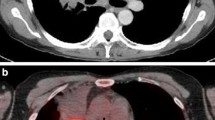Abstract
Purpose
The purpose of this study was to compare the diagnostic performance of the manual fusion of positron emission tomography (PET) and computed tomography (CT) images with that of CT alone and that of side-by-side PET and CT (PET/CT) in patients with suspected recurrent lung cancer.
Procedures
Fifty-three patients who had previously had surgery for lung cancer underwent a whole-body 2-deoxy-2-[F-18]fluoro-d-glucose (FDG)-PET scan, followed by a diagnostic CT scan. The PET and CT images were fused on a workstation. CT alone, PET/CT, and fused images were evaluated separately using a five-point grading scale (0 = definitely negative, 1 = probably negative, 2 = equivocal, 3 = probably positive, and 4 = definitely positive). Lesions of grade 3 or 4 were considered positive, and diagnostic accuracy and certainty were evaluated.
Results
Overall, 67 lesions in 33 patients were considered true positive pathologically or clinically. Of these 67 lesions, the evaluation of CT, PET/CT, and fused images detected 46, 55, and 66 lesions, respectively, with the number of grade 4 lesions detected being 38, 50, and 63, respectively. The diagnostic accuracy of CT, PET/CT, and fused images according to patients was 75%, 79%, and 87%, respectively.
Conclusion
These results suggest that interpreting fused images increased diagnostic certainty for detecting recurrence and provided more accurate diagnoses.



Similar content being viewed by others
References
Coleman RE (1999) PET in lung cancer. J Nucl Med 40:814–820
Dwamena BA, Sonnad SS, Angobaldo JO, Wahl RL (1999) Metastases from non-small cell lung cancer: mediastinal staging in the 1990s—meta-analytic comparison of PET and CT. Radiology 213:530–536
Higashi K, Matsunari I, Ueda Y et al. (2003) Value of whole-body FDG PET in management of lung cancer. Ann Nucl Med 17:1–14
Hicks RJ, Kalff V, MacManus MP et al. (2001) The utility of (18)F-FDG PET for suspected recurrent non-small cell lung cancer after potentially curative therapy: impact on management and prognostic stratification. J Nucl Med 42:1605–1613
Hellwig D, Groschel A, Graeter TP et al. (2006) Diagnostic performance and prognostic impact of FDG-PET in suspected recurrence of surgically treated non-small cell lung cancer. Eur J Nucl Med Mol Imaging 33:13–21
Townsend DW, Beyer T, Blodgett TM (2003) PET/CT scanners: a hardware approach to image fusion. Semin Nucl Med 33:193–204
Antoch G, Stattaus J, Nemat AT et al. (2003) Non-small cell lung cancer: dual-modality PET/CT in preoperative staging. Radiology 229:526–533
Lardinois D, Weder W, Hany TF et al. (2003) Staging of non-small-cell lung cancer with integrated positron-emission tomography and computed tomography. N Engl J Med 348:2500–2507
Shim SS, Lee KS, Kim BT et al. (2005) Non-small cell lung cancer: prospective comparison of integrated FDG PET/CT and CT alone for preoperative staging. Radiology 236:1011–1019
Kim BT, Lee KS, Shim SS et al. (2006) Stage T1 non-small cell lung cancer: preoperative mediastinal nodal staging with integrated FDG PET/CT—a prospective study. Radiology 241:501–509
Keidar Z, Haim N, Guralnik L et al. (2004) PET/CT using 18F-FDG in suspected lung cancer recurrence: diagnostic value and impact on patient management. J Nucl Med 45:1640–1646
Slomka PJ, Dey D, Przetak C, Aladl UE, Baum RP (2003) Automated 3-dimensional registration of stand-alone (18)F-FDG whole-body PET with CT. J Nucl Med 44:1156–1167
Nakamoto Y, Sakamoto S, Okada T et al. (2005) Accuracy of image fusion using a fixation device for whole-body cancer imaging. Am J Roentgenol 184:1960–1966
Toorongian SA, Mulholland GK, Jewett DM, Bachelor MA, Kilbourn MR (1990) Routine production of 2-deoxy-2-[18F]fluoro-D-glucose by direct nucleophilic exchange on a quaternary 4-aminopyridinium resin. Int J Radiat Appl Instrum B 17:273–279
Hudson HM, Larkin RS (1994) Accelerated image reconstruction using ordered subsets of projection data. IEEE Trans Med Imaging 13:601–609
Nakamoto Y, Sakamoto S, Okada T et al. (2007) Clinical value of manual fusion of PET and CT images in patients with suspected recurrent colorectal cancer. Am J Roentgenol 188:257–267
Kim JH, Czernin J, Allen-Auerbach MS et al. (2005) Comparison between 18F-FDG PET, in-line PET/CT, and software fusion for restaging of recurrent colorectal cancer. J Nucl Med 46:587–595
Cohade C, Osman M, Marshall LT, Wahl RL (2003) PET-CT: accuracy of PET and CT spatial registration of lung lesions. Eur J Nucl Med Mol Imaging 30:721–726
Lardinois D, Weder W, Roudas M et al. (2005) Etiology of solitary extrapulmonary positron emission tomography and computed tomography findings in patients with lung cancer. J Clin Oncol 23:6846–6853
Nie Y, Li Q, Li F, Pu Y, Appelbaum D, Doi K (2006) Integrating PET and CT information to improve diagnostic accuracy for lung nodules: a semiautomatic computer-aided method. J Nucl Med 47:1075–1080
van Der Wel A, Nijsten S, Hochstenbag M et al. (2005) Increased therapeutic ratio by 18FDG-PET CT planning in patients with clinical CT stage N2-N3M0 non-small-cell lung cancer: a modeling study. Int J Radiat Oncol Biol Phys 61:649–655
Goerres GW, Burger C, Schwitter MR, Heidelberg TN, Seifert B, von Schulthess GK (2003) PET/CT of the abdomen: optimizing the patient breathing pattern. Eur Radiol 13:734–739
Gilman MD, Fischman AJ, Krishnasetty V, Halpern EF, Aquino SL (2006) Optimal CT breathing protocol for combined thoracic PET/CT. Am J Roentgenol 187:1357–1360
Allen-Auerbach M, Yeom K, Park J, Phelps M, Czernin J (2006) Standard PET/CT of the chest during shallow breathing is inadequate for comprehensive staging of lung cancer. J Nucl Med 47:298–301
Author information
Authors and Affiliations
Corresponding author
Rights and permissions
About this article
Cite this article
Nakamoto, Y., Senda, M., Okada, T. et al. Software-based Fusion of PET and CT Images for Suspected Recurrent Lung Cancer. Mol Imaging Biol 10, 147–153 (2008). https://doi.org/10.1007/s11307-008-0131-x
Received:
Revised:
Accepted:
Published:
Issue Date:
DOI: https://doi.org/10.1007/s11307-008-0131-x




